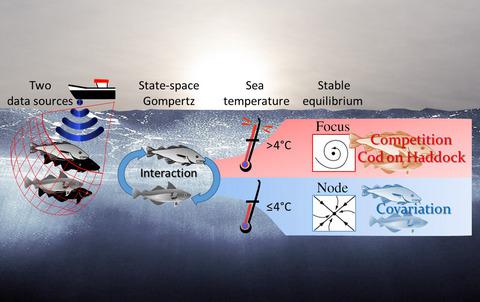当前位置:
X-MOL 学术
›
Glob. Change Biol.
›
论文详情
Our official English website, www.x-mol.net, welcomes your
feedback! (Note: you will need to create a separate account there.)
Nonlinearity in interspecific interactions in response to climate change: Cod and haddock as an example.
Global Change Biology ( IF 10.8 ) Pub Date : 2020-07-04 , DOI: 10.1111/gcb.15264 Joël M Durant 1 , Kotaro Ono 2 , Nils Chr Stenseth 1, 3 , Øystein Langangen 1, 4
Global Change Biology ( IF 10.8 ) Pub Date : 2020-07-04 , DOI: 10.1111/gcb.15264 Joël M Durant 1 , Kotaro Ono 2 , Nils Chr Stenseth 1, 3 , Øystein Langangen 1, 4
Affiliation

|
Climate change has profound ecological effects, yet our understanding of how trophic interactions among species are affected by climate change is still patchy. The sympatric Atlantic haddock and cod are co‐occurring across the North Atlantic. They compete for food at younger stages and thereafter the former is preyed by the latter. Climate change might affect the interaction and coexistence of these two species. Particularly, the increase in sea temperature (ST) has been shown to affect distribution, population growth and trophic interactions in marine systems. We used 33‐year long time series of haddock and cod abundances estimates from two data sources (acoustic and trawl survey) to analyse the dynamic effect of climate on the coexistence of these two sympatric species in the Arcto‐Boreal Barents Sea. Using a Bayesian state‐space threshold model, we demonstrated that long‐term climate variation, as expressed by changes of ST, affected species demography through different influences on density‐independent processes. The interaction between cod and haddock has shifted in the last two decades due to an increase in ST, altering the equilibrium abundances and the dynamics of the system. During warm years (ST over ca. 4°C), the increase in the cod abundance negatively affected haddock abundance while it did not during cold years. This change in interactions therefore changed the equilibrium population size with a higher population size during warm years. Our analyses show that long‐term climate change in the Arcto‐Boreal system can generate differences in the equilibrium conditions of species assemblages.
中文翻译:

种间相互作用对气候变化的响应非线性:以鳕鱼和黑线鳕为例。
气候变化具有深远的生态影响,但是我们对物种之间的营养相互作用如何受气候变化影响的理解仍然很少。同伴的大西洋黑线鳕和鳕鱼在北大西洋同时出现。他们在较年轻的阶段争夺食物,此后前者被后者捕食。气候变化可能会影响这两个物种的相互作用和共存。特别是,海水温度(ST)的升高已显示出会影响海洋系统中的分布,种群增长和营养相互作用。我们使用了来自两个数据源(声学和拖网调查)的长达33年的黑线鳕和鳕鱼丰度估计序列,以分析气候对北极至北巴伦支海这两种同胞物种共存的动态影响。使用贝叶斯状态空间阈值模型,我们证明,以ST的变化表示的长期气候变化会通过对密度无关过程的不同影响来影响物种的人口统计学。由于ST的增加,鳕鱼和黑线鳕之间的相互作用在过去的二十年中发生了变化,从而改变了平衡丰度和系统动力学。在温暖的年份(ST大约在4°C以上),鳕鱼丰度的增加对黑线鳕的丰度产生负面影响,而在寒冷的年份则没有。因此,相互作用的这种变化在温暖的年份改变了平衡种群的数量,并增加了种群数量。我们的分析表明,Arcto-Boreal系统中的长期气候变化会在物种集合的平衡条件上产生差异。通过对密度无关过程的不同影响来影响物种人口统计学。由于ST的增加,鳕鱼和黑线鳕之间的相互作用在过去的二十年中发生了变化,从而改变了平衡丰度和系统动力学。在温暖的年份(ST大约在4°C以上),鳕鱼丰度的增加对黑线鳕的丰度产生负面影响,而在寒冷的年份则没有。因此,相互作用的这种变化在温暖的年份改变了平衡种群的数量,并增加了种群数量。我们的分析表明,Arcto-Boreal系统中的长期气候变化会在物种集合的平衡条件上产生差异。通过对密度无关过程的不同影响来影响物种人口统计学。由于ST的增加,鳕鱼和黑线鳕之间的相互作用在过去的二十年中发生了变化,从而改变了平衡丰度和系统动力学。在温暖的年份(ST大约在4°C以上),鳕鱼丰度的增加对黑线鳕的丰度产生负面影响,而在寒冷的年份则没有。因此,相互作用的这种变化在温暖的年份改变了平衡种群的数量,并增加了种群数量。我们的分析表明,Arcto-Boreal系统中的长期气候变化会在物种集合的平衡条件上产生差异。由于ST的增加,鳕鱼和黑线鳕之间的相互作用在过去的二十年中发生了变化,从而改变了平衡丰度和系统动力学。在温暖的年份(ST大约在4°C以上),鳕鱼丰度的增加对黑线鳕的丰度产生负面影响,而在寒冷的年份则没有。因此,相互作用的这种变化在温暖的年份改变了平衡种群的数量,并增加了种群数量。我们的分析表明,Arcto-Boreal系统中的长期气候变化会在物种集合的平衡条件上产生差异。由于ST的增加,鳕鱼和黑线鳕之间的相互作用在过去的二十年中发生了变化,从而改变了平衡丰度和系统动力学。在温暖的年份(ST大约在4°C以上),鳕鱼丰度的增加对黑线鳕的丰度产生负面影响,而在寒冷的年份则没有。因此,相互作用的这种变化在温暖的年份改变了平衡种群的数量,并增加了种群数量。我们的分析表明,Arcto-Boreal系统中的长期气候变化会在物种集合的平衡条件上产生差异。因此,相互作用的这种变化在温暖的年份改变了平衡种群的数量,并增加了种群数量。我们的分析表明,Arcto-Boreal系统中的长期气候变化会在物种集合的平衡条件上产生差异。因此,相互作用的这种变化在温暖的年份改变了平衡种群的数量,并增加了种群数量。我们的分析表明,Arcto-Boreal系统中的长期气候变化会在物种集合的平衡条件上产生差异。
更新日期:2020-07-04
中文翻译:

种间相互作用对气候变化的响应非线性:以鳕鱼和黑线鳕为例。
气候变化具有深远的生态影响,但是我们对物种之间的营养相互作用如何受气候变化影响的理解仍然很少。同伴的大西洋黑线鳕和鳕鱼在北大西洋同时出现。他们在较年轻的阶段争夺食物,此后前者被后者捕食。气候变化可能会影响这两个物种的相互作用和共存。特别是,海水温度(ST)的升高已显示出会影响海洋系统中的分布,种群增长和营养相互作用。我们使用了来自两个数据源(声学和拖网调查)的长达33年的黑线鳕和鳕鱼丰度估计序列,以分析气候对北极至北巴伦支海这两种同胞物种共存的动态影响。使用贝叶斯状态空间阈值模型,我们证明,以ST的变化表示的长期气候变化会通过对密度无关过程的不同影响来影响物种的人口统计学。由于ST的增加,鳕鱼和黑线鳕之间的相互作用在过去的二十年中发生了变化,从而改变了平衡丰度和系统动力学。在温暖的年份(ST大约在4°C以上),鳕鱼丰度的增加对黑线鳕的丰度产生负面影响,而在寒冷的年份则没有。因此,相互作用的这种变化在温暖的年份改变了平衡种群的数量,并增加了种群数量。我们的分析表明,Arcto-Boreal系统中的长期气候变化会在物种集合的平衡条件上产生差异。通过对密度无关过程的不同影响来影响物种人口统计学。由于ST的增加,鳕鱼和黑线鳕之间的相互作用在过去的二十年中发生了变化,从而改变了平衡丰度和系统动力学。在温暖的年份(ST大约在4°C以上),鳕鱼丰度的增加对黑线鳕的丰度产生负面影响,而在寒冷的年份则没有。因此,相互作用的这种变化在温暖的年份改变了平衡种群的数量,并增加了种群数量。我们的分析表明,Arcto-Boreal系统中的长期气候变化会在物种集合的平衡条件上产生差异。通过对密度无关过程的不同影响来影响物种人口统计学。由于ST的增加,鳕鱼和黑线鳕之间的相互作用在过去的二十年中发生了变化,从而改变了平衡丰度和系统动力学。在温暖的年份(ST大约在4°C以上),鳕鱼丰度的增加对黑线鳕的丰度产生负面影响,而在寒冷的年份则没有。因此,相互作用的这种变化在温暖的年份改变了平衡种群的数量,并增加了种群数量。我们的分析表明,Arcto-Boreal系统中的长期气候变化会在物种集合的平衡条件上产生差异。由于ST的增加,鳕鱼和黑线鳕之间的相互作用在过去的二十年中发生了变化,从而改变了平衡丰度和系统动力学。在温暖的年份(ST大约在4°C以上),鳕鱼丰度的增加对黑线鳕的丰度产生负面影响,而在寒冷的年份则没有。因此,相互作用的这种变化在温暖的年份改变了平衡种群的数量,并增加了种群数量。我们的分析表明,Arcto-Boreal系统中的长期气候变化会在物种集合的平衡条件上产生差异。由于ST的增加,鳕鱼和黑线鳕之间的相互作用在过去的二十年中发生了变化,从而改变了平衡丰度和系统动力学。在温暖的年份(ST大约在4°C以上),鳕鱼丰度的增加对黑线鳕的丰度产生负面影响,而在寒冷的年份则没有。因此,相互作用的这种变化在温暖的年份改变了平衡种群的数量,并增加了种群数量。我们的分析表明,Arcto-Boreal系统中的长期气候变化会在物种集合的平衡条件上产生差异。因此,相互作用的这种变化在温暖的年份改变了平衡种群的数量,并增加了种群数量。我们的分析表明,Arcto-Boreal系统中的长期气候变化会在物种集合的平衡条件上产生差异。因此,相互作用的这种变化在温暖的年份改变了平衡种群的数量,并增加了种群数量。我们的分析表明,Arcto-Boreal系统中的长期气候变化会在物种集合的平衡条件上产生差异。











































 京公网安备 11010802027423号
京公网安备 11010802027423号